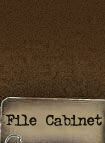|
REASON FOR INVESTIGATION:
The investigation was initiated
after this agency understood that
the Willem Hikspoors Bridge "Her
weakness was her strength"-story
seemed to become more of an urban
legend over time. Local popular
believe in the city of Eindhoven,
The Netherlands, area has it that a
German reconnaissance unit, looking
for a suitable bridge for the 107th
Armored Brigade to cross the Dommel
River into Eindhoven on the 19th of
September 1944, decided not to cross
the Soeterbeek Bridge after being
convinced by a local civilian, named
Willem Hikspoors, that the river
span would collapse under the weight
of their vehicles, thus saving the
city from a costly tank battle
between German armored units and the
Allied forces which had just
liberated Eindhoven from German
occupation on the 18th of September.
This Battle Study establishes the
details regarding the bridge's
actual weakness that supposedly
saved the free city of Eindhoven.
SYNOPSIS:
The story of the Soeterbeek Bridge
is best described from both the
views of the local civilians who
experienced the incident as from the
German side.
Dutch version
The following story was written by
Mr. Frans Kortie, one of the
founders and original Chairman of
the
Society of Dutch Airborne Friends.
"Because of the Hikspoors Bridge,
the Hun had to retreat.
Also in the day after the
liberation, the citizens of
Eindhoven fully enjoy their new
found freedom. They celebrated
together with many people from the
surrounding villages. Even though
their municipalities have not yet
been liberated, still they want to
experience, in person, the 'happy
end' of over four years of war. Also
the children of Willem Hikspoors
have bicycled to Son to meet the
Airborne liberators. Together, they
also watch the endless long tank
column of the British Army, which is
now, finally, 'full speed' en route
to Nijmegen and Arnhem, across the
Corridor, secured by the 101st
Airborne Division.
Father Hikspoors, gardener of the
aristocratically Smits van Oyen
family, has quietly stayed at home.
He enjoys the relaxing work in the
garden of the Soeterbeek Estate. He
hears a lot about the joyful
reception of the liberators in Son
and Eindhoven. He cannot believe the
rumor, that Germans have returned to
near or inside Nuenen. But then
again, one can never know...
It does occur to him, that there are
quite a number of people who come by
on their bicycles in a rather hasty
pace. An older man steps down from
his bicycle and shouts: 'Go
inside quickly, The Germans are
coming'. The good man has hardly
disappeared out of sight when
Hikspoors spots strange vehicles
approaching from the distance.
The Germans come in five half
tracked vehicles and stop right in
front of the Dommel River bridge.
One soldier, armed with a
machine-pistol, crawls out of his
vehicle and looks at the bridge from
all sides. Hikspoors understands his
intentions. He walks over to him and
says in his best German: 'brug is
viel zu swag' (bridge is far too
weak). The German does not seem to
be convinced. Hikspoors keeps
trailing him and finally shows the
soldier the sign: 'Maximum weight 8
tons'. The German is somewhat
impatient, but does seem to be
convinced now.
A frightening adventure at
Soeterbeek
That moment, suddenly a boy arrives
by bicycle. Enthusiastically, he
starts taking photographs. It is the
young nobleman Jan Smits van Oyen,
who seemingly thinks that these are
British tanks. Even before he
realizes his foolish mistake, the
Germans take him in a forceful hold.
A furious officer curses him and
throws the expensive camera into the
Dommel River. With a pistol in his
back, the nobleman is lead away.
Hikspoors fears that the young son
of his boss will be executed on the
spot. How in God's name can he
prevent this? He prays for good
advice. While the Germans keep the
absolutely nervous nobleman at
gunpoint, the drivers try to turn
their vehicles which are very
difficult to operate. This is very
challenging on this narrow road.
Hikspoors helps them with this tough
job, but does take a lot of extra
time for it. He keeps the drivers
busy long and intensely enough, that
the nobleman, on Hikspoors' gesture,
disappears like a hare into the
underbrush alongside the road. His
guards chase him, while shooting and
swearing. God and destiny are
merciful to him. Nobleman Jan does
not get hit. He has always been
grateful to his savior. Also, when
nobleman Jan became the Mayor of
Nuenen. Many citizens of Eindhoven,
especially from the suburb of
Woensel, have honored Hikspoors
later as well, because through his
courageous acting he succeeded in
preventing a tank battle in Woensel.
The bridge was given Hikspoors’ name
and much later he received a
decoration. This was well earned,
because he delayed the counter
attacks of the still undefeated
German Army, thus securing our
freedom."
German version
Robert Kershaw has reconstructed the
German reaction to Operation Market
Garden in his book 'It never
snows in September'. On pages 118
and 119 we read this about the
strength of the force that went by
Soeterbeek:
"107 Panzer Brigade, re-routed
from Aachen, was on the march. After
detraining, it moved in clattering,
exhaust-shrouded columns toward
Helmond. The brigade was totally
armoured and motorised. Built around
a battalion of Mark V 'Panther'
tanks, it possessed a
Panzer-grenadier infantry battalion
mounted in armoured half-tracks,
further supplemented by a
self-propelled assault gun company,
as well as supply and transport
detachments. The whole force moved
under its on effective anti-aircraft
umbrella also mounted on tracks."

On pages 144-145 we read about the
deployment of the 107th Brigade
during the initial phase of
Operation Market Garden:
"The raids by Panzer Brigade
107, 19-20 September 1944...
Major Freiherr von Maltzahn,
the commander of Panzer Brigade 107,
had been given a difficult task:
attack across Son and take St
Oedenrode, and thereby slice off the
head of the British XXX Corps
advance on Grave. Enemy force were
as yet an undetermined number of
air-landed battalions, relatively
easy meat for his mobile armoured
formation. They had been rerouted
from an original operational
commitment on the eastern front, and
this new task was more
preferable[...]
Reluctant to commit his brigade to
going recklessly into the unknown,
von Maltzahn decided upon a
reconnaissance in force. His chosen
approach from the south-east towards
Son was flat, but sandy and boggy;
Eindhoven to his left was probably
now occupied, and the axis of
advance was further channelled by
the line of the Wilhelmina
canal itself, an obstacle forward
and to the right. A small river
tributory running due south from the
canal,
parallel to Eindhoven, restricted
armoured movements even
further.[...] A shock assault was a
impractical proposition, but, by
using the trees that screened their
advance, a heavy 'raid' appearing
ghost-like from nowhere might
substitute. [...] The attack came in
from the south, and almost
immediately threatened to overrun
the recently erected Bailey Bridge."
Why consider crossing the
Soeterbeek Bridge?
The terrain South of Son (the
Nuenen-Nederwetten area) consisted
(and still consists) mainly of
narrow brick roads with trees
planted on each side and marshy
meadows. An attack could therefore
only be made by driving up to the
target in column and not by forming
a broad front with tanks and
infantry; Eastern Front-style. The
Brigade staff would most likely have
sent a reconnaissance patrol to try
and find alternative routes of
advance to Son in order to let more
armor and troops arrive at the
objective simultaneously. The
vehicles at the Soeterbeek Bridge
must have been on such a search for
a parallel route.
Details regarding the weakness of
the Soeterbeek Bridge
In the Eindhoven Regional Archives
we have found the records that the
Municipality of Nuenen kept
regarding the man-made road between
their village and the Municipality
of Woensel.
The bridge crosses the Dommel River.
The middle of the river forms the
boundary between Woensel on its West
bank and Nuenen, East of the river.
Therefore the bridge is owned by
both municipalities; each for 50%.
(click to enlarge)
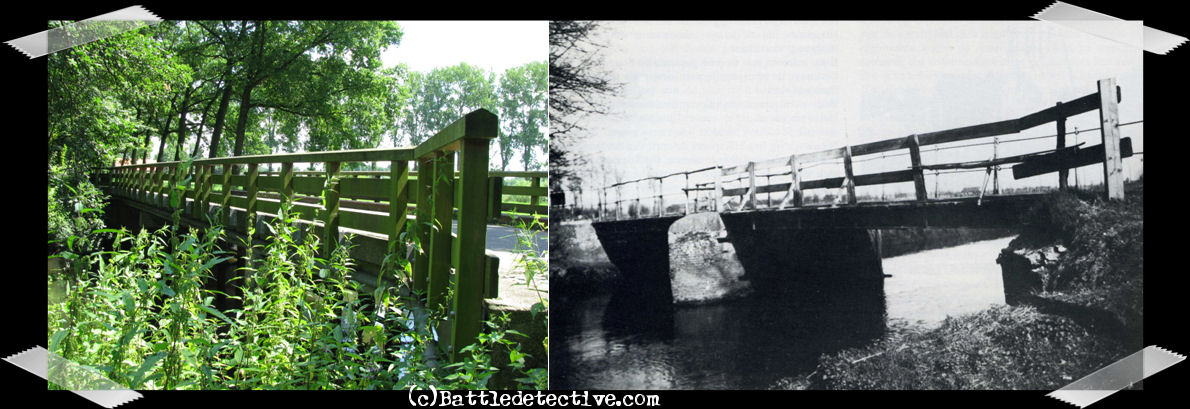
The bridge at
Soeterbeek spanning the Dommel
River; Now & Then.
Time-line
On the 10th and the 11th of May 1885
the municipal councils of Nuenen and
Woensel each declared that a road
between their towns should be
constructed, with a bridge across
the Dommel River.
The bridge was built a few years
later, at a
cost of approximately 11.000,- Dutch
guilders.
In January 1909 the bridge needed
repair and after a closed quotation
from nine applicants the company of
Petrus de Groot was granted to do
the job for 478,- guilders.
On the
8th and the 17th of April Woensel
billed Nuenen for half the cost.
On January 1st, 1920 the
Municipality of Eindhoven became
Greater Eindhoven, annexing Woensel.
The Western half of the Bridge
became property of the city of
Eindhoven from then on.
In May 1922 the bridge was inspected
by an official from the Provincial
Water Works and subsequently, on the
24th of May 1922, the
Province reported to Nuenen and
Eindhoven that the bridge’s road
surface needed repair.
On the 21st of June 1922
Eindhoven had the pine wooden bridge
deck repaired and billed Nuenen for
half the cost.
On the 18th of March 1924
Eindhoven informed Nuenen that,
regarding their liability if
accidents would occur, they were
about to post a sign on their side
of the bridge reading "maximum
allowed wheel load 2480 kilograms.;
total weight 7440 kilograms" and
advised Nuenen to do the same on the
East end of the bridge.
On the 21st of March 1935 a
construction expert named D.
Breukers reported to the mayor of
Nuenen that the municipality of
Eindhoven had repaired their stretch
of the bridge's road surface.
Because the surface on the Nuenen
stretch was in a bad shape, repair
was much desirable.
This was the most recent document on
file in the Archive.
We assume that, as a result of the
Mr. Breukers's report, the bridge
was repaired again and possibly
improved. This assumption was made
because various accounts about the
events in September 1944 speak of a
road sign saying that the Soeterbeek
Bridge could take a maximum load of
8 tons.
Actual strength
From Mrs. Petra Wendstedt-Pulles
(president of the
Screaming Eagles of World War
Two-foundation), we received
copies of several publications on
the event at the Soeterbeek Bridge.
Of interest is that in many accounts
the German vehicles at the bridge
were described as 'tanks', and not
'half-tracks' as in the account by
Mr. Kortie. Tanks would mean
Panzerkampfwagen V 'Panther' tanks
of the 107th Brigade, weighing 44
tons and halftracks the 8 ton
Sonderkraftfahrzeug 251.
Significant for this Battle Study
are two interviews with Mr. Willem
Hikspoors, held shortly after the
war.
In the Eindhovensch Dagblad
(Eindhoven Daily Newspaper) of
October 19th, 1946 we read:
"It was then decided to return
and the soldier, who had inspected
the bridge climbed back into the
tank.
If only they had known, that not
even that long ago, a tractor with a
road roller, together weighing at
least 50 tons, 'came across the
bridge', and that some days
thereafter many American tanks would
cross the bridge without any
worries, after having first neatly
driven off the side railings, which
gave too little room."
The Lichtstadkrant (City of Light
Newspaper) of September 18th, 1947
also featured an interview with
Willem Hikspoors. In the article we
read:
"Hikspoors is a modest man: he
does not add anything to the facts,
and takes nothing away from them,
but the bridge was not too weak for
Churchill tanks to roar across it on
the 20th of September in order to
engage the enemy, the same enemy
who, the night before had made an
about turn at hardly 5 kilometers
distance from the liberated
city-in-celebration."
(click to enlarge)

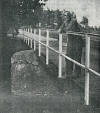
Willem Hikspoors
posing on the Soeterbeek
bridge for the 1946 and 1947
newspaper articles
CONCLUSIONS:
|
|
There have been many speculations as
to the real reason for the
reconnaissance team of the 107th
Armored Brigade to decide not to
cross the Soeterbeek Bridge.
Hikspoors was bluffing and the
bridge may have held the weight of
the German Panther tanks
If a tractor-roller combination,
weighing 50 tons and Churchill
tanks, weighing approximately 40
tons, did not cause the bridge to
collapse, one or more German Panther
V tanks, weighing 44 tons, may have
also been able to reach the
Eindhoven bank of the Dommel River
safely.
Viet Nam veteran Joseph M. Bossi,
former president of the 101st
Airborne Division Association,
explained to Battledetective.com the
US Army policy when encountering a
bridge of questionable strength:
"You
send one vehicle across the bridge
and let it drive slowly without
shifting gears.
If the bridge holds,
send more vehicle across, one at a
time.
This is called a 'critical
crossing'.
The rule of thumb is that
you can easily cross a bridge with
vehicles that are 10% heavier than
what the bridge rating indicates.
But when your vehicles are 50%
heavier or more, you are looking for
trouble.'"
The Germans could have tried this.
A bridge rating on a sign does not
show the exact amount of stress that
it takes to make the bridge deck
collapse.
German reluctance to pick a fight
in Eindhoven
It has also been suggested that
battle weary tankers at the
Soeterbeek bridge did not want to
drive into Eindhoven because that
would lead to a certain clash
between them and the numerical
superior elements of the British XXX
Corps. This can be considered as not
the real reason. The 107th Brigade
showed no hesitation when engaging
the US 101st Airborne and attacking
the Bailey Bridge at Son, that same
day. And later on the 22nd when the
brigade cut Hell's Highway at
Koevering near Veghel, the 107th
showed an aggressiveness unseen in
battle weary units.
No tactical advantage for a drive
into Eindhoven
It is our belief that the tankers
made their decision to return, on
their own judgment. They had a
marching order: attack the bridge at
Son. Lead elements of the Brigade
were driving towards it via
Nederwetten. Finding another road
that would allow a second column to
advance parallel to the original
route of advance, would suit the
attackers, as it would double the
force arriving at the objective.
The road across the Soeterbeek
Bridge would not get the Panzers to
Son in a manner comparable to the
route through Nederwetten. This was
not the time to start a tank battle
in a built-up area. Besides,
military doctrine dictates that you
cut a supply line (which Hell's
Highway in fact was) where it is most
vulnerable. The Bailey bridge at Son
was such a weak spot. And so was the
open terrain at Koevering which gave
no concealment for the traffic on
Hell's Highway.
It is not our intention to prove the
"Gardener who saved Eindhoven-"story
wrong, but in conclusion we feel
safe to say that it is very doubtful
if it was Hikspoors pointing to the
8 ton-sign alone, that convinced the
Panzer crew to retrace their route.
They had more reasons not to go
across. Hikspoors, nevertheless
showed great courage in both
his efforts to convince the Germans
not to go into Eindhoven and,
subsequently distracting the captors
of Jan Smits-van Oyen.

EXHIBITS:
The rural area between Nuenen and
Eindhoven seems uninfluenced by
modern times. Especially the stretch
of road near the Dommel River Bridge
and the Soeterbeek Estate look as if
nothing has changed since 1944. This is an
impression of the area:
(click on the
thumbnails to enlarge)

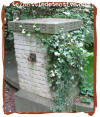

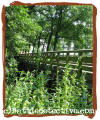
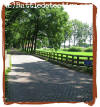
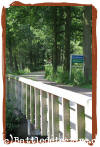
|


